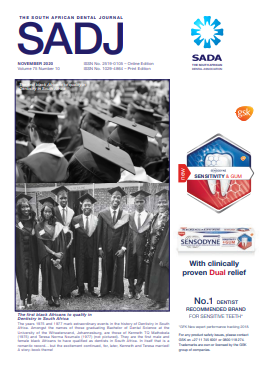Dental images - Their use and abuse
DOI:
https://doi.org/10.17159/2519-0105/2020/v75no10a9Keywords:
dental imagesAbstract
Patients' exposure to medical and dental radiographic examination has increased over the years,1 with dental X-ray procedures now accounting for almost one-third of all radiographic examinations.2 Although they only contribute 2-4% towards the collective effective dose of exposure, all efforts should be made to minimize the amount taken and to keep exposure as low as diagnostically achievable.2
When considering radiographic examinations, the potential diagnostic or therapeutic benefits to the individual or society need to be weighed up against the possible risks that the exposure may cause, taking into account the "efficacy, and benefits and risks of alternative techniques that have the same objectives but involve no or less radiation".2,3
To this end the acronym ALARA was coined to stress that all diagnostic radiographs should aim to keep doses as low as reasonably achievable without compromising the diagnosis.1 With the advent of digital imaging there has been a trade-off between image quality and reduced radiation dosage. As such the term has been altered to ALADA, as low as diagnostically acceptable, to reflect this compromise.2
Downloads
References
Holmboe E, Bernabeo E. The "special obligation" of the modern Hippocratic Oath for the 21st century medicine. Med Edu. 2014; 48(1): 87-942.
Davey LM. The oath of Hippocrates: an historical review. Neurosurg. 2001; 49: 554-663.
Sulmasy D. What is an oath and why should physician swear one? Theor Med Bioeth. 1999; 20: 329-46.
Steihm ER. Adverse effects of human immunoglobulin therapy. Transfus Med Rev. 2013; 27: 171-8.
Legnani P, et al. Atmospheric contamination during dental procedures. Quint Int. 1994; 25: 435-9.
Checchi V et al. COVID-19 dentistry related aspects: a literature review. International Dental Journal. 2020. https://doi.org/10.1111/idj.12601.
Ather A, et al. Coronavirus disease 19 (COVID-19): implications for dental care. Journal of Endodontics. 2020; 46(9): 1341 -2.
Ge Z, et al. Possible aerosol transmission of COVID-19 and special precautions in dentistry. Journal of Zhejiang University - SCIENCE B. 2020; 1-8. doi.org/10.1631/jzus. B2010010.
Xiao A, et al. Dynamic profile of RT-PCR findings from 301 COVID-19 patients in Wuhan, China: a descriptive study. Journal of Clinical Virology. 2020; doi.org/10.1016/j.jcv.2020. 104346.
Watkin, et al. Top E.R Doctor Who Treated Virus Patients Dies by Suicide. The New York Times. Available at: https://www.nytimes.com/2020/04/27/nyregion/new-york-city-doctor-suicide-coronavirus.html/ (Accessed: 19 June 2020).
Sokol DK. Virulent epidemics and the scope of healthcare worker's duty of care. Emerg Infect Dis. 2006; 12(8): 1238-41. doi:10.3201/eid1208.060360.
Ruderman C, et al. On epidemics and the duty to care: whose duty? who care? BMC Ethics 2006; 7(1): 1-6.
Deanery S, et al. Healthcare worker's perception of duty to work during influenza pandemic. J Med Ethics. 2010; 36(1): 12-18.
Jeffrey DI. Relational ethical approach to the COVID-19 pandemic. J Med Ethics. 2020; 0: 1-4.
Hruschka, J. The greatest happiness principle and other early German anticipations of utilitarian theory. Utilitas. 1991; 3(2): 165-77.
Singer PA, et al. Ethics and SARS: Lessons from Toronto. BMJ. 2003; 327: 1342-4.
Dwyer J, Tsai DF. Developing the duty to treat: HIV, SARS and the next epidemic. J Med Ethics. 2008; 34(1): 7-10.
Beauchamp T, Childress J. Principles of biomedical ethics, 2nd ed. New York: Oxford University Press, 1983.
Aristotle. Nichomachean ethics. In: McKeon R, ed. The basic works of Aristotle. New York: Random House, 1941.
Tomlinson T. Caring for risky patient's duty or virtue? J Med Ethics. 2008; 34(6): 458-62.
Downloads
Published
Issue
Section
License
Copyright (c) 2021 Leanne M Sykes, A Uys, C Bradfield, Nicolaas W Van Reede Van Oudtshoorn

This work is licensed under a Creative Commons Attribution-NonCommercial 4.0 International License.






.png)